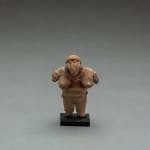Chupicuaro Sculpture of a Voluptuous Woman, 350 BCE - 250 CE
Terracotta
1.75 x 2.5
PF.1968
Further images
The remains of a once vibrant culture are now submerged under a lake. Fortunately, excavations in the 1940's on the site were able to uncover sufficient artifacts to give us...
The remains of a once vibrant culture are now submerged under a lake. Fortunately, excavations in the 1940's on the site were able to uncover sufficient artifacts to give us an intriguing picture of people who lived there centuries ago. Chupicuaro was the elaborate burial ground of a village above the Lerma River in the state of Guanajuato, eighty miles northwest of the Valley of Mexico. The abundant offerings of pottery, jade, and figurines discovered there attest to a flourishing artistic culture. One of the most endearing types of the clay objects is the small female figures, or 'pretty ladies'. They typically show a naked female with short arms, extended stomach and a fancy coiffure or headdress.
Boldly voluptuous, this little woman belongs to a tradition as old as time itself, the fertility Goddess. Mankind's earliest religion focused on the mother, the generous source of life itself. This powerful figure seems the epitome of abundant femininity, a female possessed of eternal powers. She is sister to Neolithic idols, to Astarte, to Isis, to Venus, and all other such goddesses. We have no difficulty recognizing her magic, in comprehending her enduring mystery.
Boldly voluptuous, this little woman belongs to a tradition as old as time itself, the fertility Goddess. Mankind's earliest religion focused on the mother, the generous source of life itself. This powerful figure seems the epitome of abundant femininity, a female possessed of eternal powers. She is sister to Neolithic idols, to Astarte, to Isis, to Venus, and all other such goddesses. We have no difficulty recognizing her magic, in comprehending her enduring mystery.







